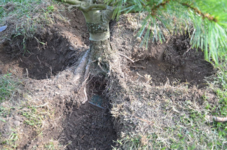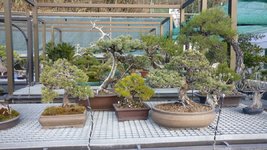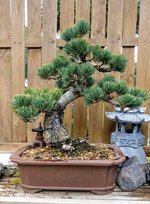Joe2758
Yamadori
I have the bonsai today master series book on pines. Can I apply the info on JWP to my Scots pines for the most part?
Can I apply the info on JWP to my Scots pines for the most part?
so very trueJWP appears to be more disease tolerant than
the Scots or other 2 needle pines like Mugo and JBP
again, very trueGrow zones above 7 aren't best suited for JWP
Where does this zone 7 limit for JWP come from?Grow zones above 7 aren't best suited for JWP, especially as the climate is warming.
Is this a grafted white pine or own root stock? Intrested as might put white pine back on the table for meWhere does this zone 7 limit for JWP come from?
I have quite a few now that seem to be doing well in what I believe is zone 9.
I have both. Started out with 3 seedlings germinated from seed collected in Tasmanian Botanic gardens. I've since grafted some on JBP and grown more as cuttings from the original seedlings. The older seedlings are around 15 years old now and appear to be growing strong.Is this a grafted white pine or own root stock? Intrested as might put white pine back on the table for me
Wait.. Scots pines and sensitive roots?! It's one of the pines with an insane distribution range; Mediterranean to Siberia.If I grow scotch pine from seed directly in the ground, will I have problems digging it back out later because of the more sensitive roots? I am much more confident with how deciduous species respond.
Best news I've heard all week!Wait.. Scots pines and sensitive roots?! It's one of the pines with an insane distribution range; Mediterranean to Siberia.
Scots pine roots are the least sensitive to disturbances if you'd ask me. Maybe EWP is tougher.. but compared to JWP, scots is way easier to work with.
Grow them on a tile though if you have the chance.
lol that one's a no-brainerYou know you have problems when you get excited about a post that at first glance reads...
scotch vs japanese white wine
Where does this zone 7 limit for JWP come from?
I have quite a few now that seem to be doing well in what I believe is zone 9.


This is awesome good news to me, given your experience of 15 years with JWP on their own roots in zone 9.I have both. Started out with 3 seedlings germinated from seed collected in Tasmanian Botanic gardens. I've since grafted some on JBP and grown more as cuttings from the original seedlings. The older seedlings are around 15 years old now and appear to be growing strong.
This depends on the thickness of the nebari when you're done trimming it.putting a tile down at about 5-6 inches down

What is the point of a tile so deep. Seems pointless as a means to develop nebari or limit dept of roots to match bonsai pots because most bonsai pots will be less than 5" deep?I plan on digging my ground plants up and putting a tile down at about 5-6 inches down. Because they're in a remote location that I don't plan on watering very often.
I also have one much older mugho pine on the benches growing happily here.From my cultivation of research, I would place JWP or any other WP
in the same hardiness zone as mugo pine.
This is what I expected. Need to be very wary of just quoting anecdotal reports as they soon become lore from constant repetition despite no real evidence.Just what I've read and others have expressed on the forum.
Much to my surprise, I found JWP to grow just fine in the metro Atlanta area. I was initially under the impression they would potentially suffer from the long, hot and humid summers and short and not so cold winters. They, in fact, proved easier to grow than my JBP, who grew well but suffered from needle cast and spider mites regularly while the JWP were essentially pest free. I never grew P. sylvestris while in GA. Adair does indeed grow some fantastic JWP in GA, but he's further north and at a higher altitude which suits JWP and other alpine species even more.This depends on the thickness of the nebari when you're done trimming it.
In trying to develop the nebari, you may depending on the size of the root mass
start with a smaller tile, so as to not pile soil up on the trunk.
View attachment 472514
Here is an EWP on a 12" tile that was never lifted and trimmed.
I had decided to keep it as a landscape tree, until I didn't.
This tile is about 4" down I suppose, it came in a 3 gallon nursery can
when I planted it 10 years prior to this picture. Note the damage on the trunk
from leaving the plastic ID band on during grow out. Otherwise, the bark was really nice.
So @Wires_Guy_wires you might use a smaller 4 or 6" tile allowing the roots to drape over the edge
to seek moisture, then increase the tile size as the nebari develops rather than burying it too deep initially.
Just depends on what you have to work with.
I'm also on this side.This is what I expected. Need to be very wary of just quoting anecdotal reports as they soon become lore from constant repetition despite no real evidence.
Sometimes I wonder if the cold climate growers tell us things like this simply to justify why they choose live in such brutal conditions LOL.
.


Mmm the spelling mistake truly had my dander up!You know you have problems when you get excited about a post that at first glance reads...
scotch vs japanese white wine
